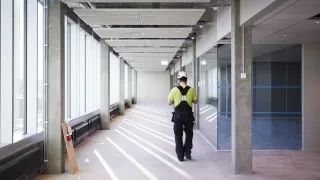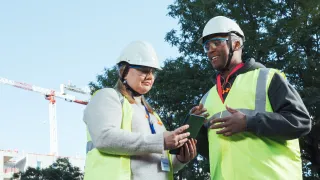Finnish Institute of Occupational Health media release, 7 March 2023
The use of lithium-ion (Li-ion) batteries has increased significantly and is expected to grow globally in the coming years. Lithium-ion batteries are also becoming increasingly common in large machines such as trucks. As batteries age and their size increases, so do the risks to safety at work.
The Finnish Institute of Occupational Health's project identified occupational safety risks throughout the life cycle of batteries and produced good practices to manage them. The project also carried out a life cycle assessment (LCA) to take account of environmental aspects and gaseous emissions.
Preparedness and trained staff are key to risk management
Batteries work on the basis of a chemical reaction. During the manufacturing phase, risks are involved particularly in the handling of chemicals. In contrast, during storage, use and transport, thermal hardening can cause a battery fire that is difficult to extinguish. The risk assessment should also take into account how batteries are charged and recycled.
When handling lithium-ion batteries, it is important to ensure that safety knowledge and precautions are in place.
"Those working with batteries must know what to do in the event of a battery fire, for example. Effective safety communication can ensure that workers know how to prevent accidents and other occupational safety risks," says Pia Perttula, Senior Researcher at the Finnish Institute of Occupational Health.
While attention is paid to preparedness and ensuring competence when working with lithium-ion batteries, it is also advisable to further increase cooperation with the fire and rescue authorities. Safety can also be promoted by improving cooperation between different actors in the value chain.
"Often, safety risks are assessed at the workplace itself, but it is good to cooperate on safety issues between workplaces at different stages of the value chain," says Pia Perttula.
Everyone can contribute to the safe use of batteries through their own actions
Workers themselves can also reduce safety risks. For example, they should only use intact and appropriate chargers to charge their equipment.
"It is also important for workplaces to consider how to ensure safe working with lithium-ion batteries and how to deal with situations such as fires," says Pia Perttula.
As lithium-ion batteries become more widespread, the good practices produced by the project can be widely used. The guidelines for safe use of batteries in the workplace have been compiled in a report on the Finnish Work Environment Fund's website: Lithium-ion batteries (Li-ion) lifecycle – occupational safety risks and risk management (Safera) | Työsuojelurahasto (tsr.fi)
Lithium-ion batteries (Li-ion) lifecycle – occupational safety risks and risk management research project
- The aim of the project was to identify occupational safety risks in the lithium-ion battery value chain and to produce guidance and good practices to improve occupational safety.
- The research targeted companies in the battery value chain in Finland and Spain, as well as stakeholders and authorities. The value chain analysed was a forklift truck with a lithium-ion battery.
- Final report of the project: Lithium-ion battery’s life cycle : safety risks and risk management at workplaces (julkari.fi)
- The project was implemented as a SAF€RA project with the Spanish GAIKER and funded by the Finnish Work Environment Fund.
Further information
- Pia Perttula, Senior Researcher, Finnish Institute of Occupational Health, +358 (0)43 820 0499, pia.perttula [at] ttl.fi (pia[dot]perttula[at]ttl[dot]fi)




